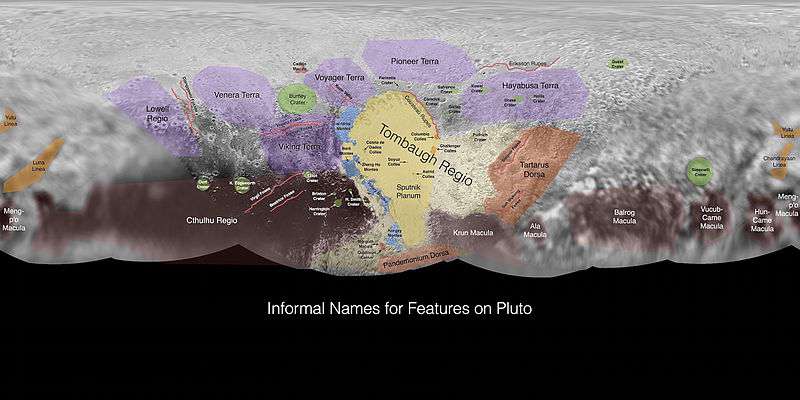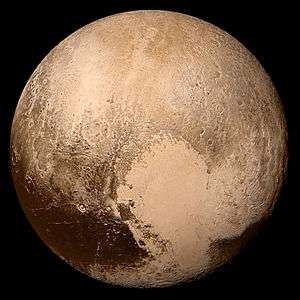List of geological features on Pluto

The geological features on Pluto are being identified by scientists working with data from the New Horizons spacecraft. The International Astronomical Union has determined that the names for these features will be chosen from the following themes:[1]
- Names for the underworld from the world's mythologies.
- Gods, goddesses, and dwarfs associated with the underworld.
- Heroes and other explorers of the underworld.
- Writers associated with Pluto and the Kuiper belt.
- Scientists and engineers associated with Pluto and the Kuiper belt.
The following is a list of unofficial names chosen by the New Horizons team but not yet approved by the IAU.[2] Not all of the names correspond with the themes listed above.
Cavi
A cavus is a hollow or steep-sided depression. One cavus has been identified on Pluto thus far; it is named after a mythological underworld.
| Feature | Named after |
|---|---|
| Quidlivun Cavus | The land on the Moon where the souls of the dead find rest in Inuit mythology |
Colles
A collis is a low hill. Plutonian colles are being named after spacecraft that operated in Earth orbit.
| Feature | Named after |
|---|---|
| Astrid Colles | The Astrid program, Sweden's first satellites |
| Challenger Colles | Honours the loss of the Space Shuttle Challenger |
| Coleta de Dados Colles | Satélite de Coleta de Dados, first Brazilian satellite |
| Columbia Colles | Honours the loss of the Space Shuttle Columbia |
| Soyuz Colles | The Soyuz program; honors the loss of Soyuz 11 |
Craters
Plutonian craters are being named after scientists and other people associated with the study of Pluto.
| Feature | Named after |
|---|---|
| Brinton | Henry Brinton, NASA administrator instrumental in Pluto studies |
| Burney | Venetia Burney, who proposed the name of Pluto |
| Coradini | Angioletta Coradini, Italian astronomer |
| Drake | Michael Julian Drake, British-American astronomer who chaired the committee that approved the New Horizons mission |
| Elliot | James L. Elliot, discoverer of Pluto's atmosphere |
| Farinella | Paolo Farinella, Italian astronomer |
| Giclas | Henry L. Giclas, an astronomer at Lowell Observatory |
| Guest | John Guest,[3] British volcanologist and planetary scientist |
| H. Smith | Harlan Smith, astronomer and director of McDonald Observatory |
| Harrington | Robert Sutton Harrington, co-discoverer of Charon |
| Hollis | Andrew J. Hollis, British astronomer |
| K. Edgeworth | Kenneth Edgeworth, Irish astronomer who posited the Kuiper Belt |
| Kowal | Charles T. Kowal, American astronomer who discovered the first centaur |
| Oort | Jan Oort, Dutch astronomer who posited the Oort Cloud |
| Pulfrich | Carl Pulfrich, German physicist who developed the blink-comparator used to discover Pluto |
| Safronov | Viktor Safronov, Russian astronomer |
| Simonelli | Damon Simonelli, American astronomer and Pluto geologist |
Dorsa
A dorsum is a ridge. Plutonian dorsa are being named after underworlds in mythology.
| Feature | Named after |
|---|---|
| Pandemonium Dorsa | Pandæmonium, the capital of Hell in the poems of John Milton |
| Tartarus Dorsa | Tartarus, the pit of hell in Greek mythology |
Fossae
A fossa is a ditch-like feature. Plutonian fossae are being named after figures associated with underworld myths.
| Feature | Named after |
|---|---|
| Beatrice Fossa | Beatrice Portinari, Purgatory to Heaven in The Divine Comedy |
| Djanggawul Fossae | Djanggawul, Yolngu creation figures from the Island of the Dead |
| Dumuzi Fossa | Dumuzid, legendary Sumerian king who replaced his wife Inanna in the underworld |
| Inanna Fossa | Inanna, Sumerian queen who descended to the underworld |
| Sleipnir Fossa | Sleipnir, the steed Odin rides to the underworld |
| Sun Wukong Fossa | Sun Wukong, the Chinese Monkey King who went to Hell |
| Virgil Fossa | Virgil, as Dante's guide through Hell and Purgatory in The Divine Comedy |
Lineae
A linea is an elongated marking. Plutonian lineae are being named after space probes.
| Feature | Named after |
|---|---|
| Chandrayaan Linea | the Chandrayaan program, India's first lunar probes |
| Luna Linea | the Luna program, the first spacecraft to visit the Moon |
| Yutu Linea | Yutu, the first Chinese lunar rover |
Maculae
A macula is a dark spot. Plutonian maculae are being named after underworld creatures from fiction and mythology.
| Feature | Named after |
|---|---|
| Ala Macula | Ala, an Igbo god of the underworld |
| Balrog Macula | balrog, an underground demon in the writings of J.R.R. Tolkien |
| Cadejo Macula | cadejo, from Central American folklore |
| Hun-Came Macula | One of the two leading Maya death gods from the Popol Vuh |
| Krun Macula | Krun, the Mandaean overlord of the underworld |
| Meng-p'o Macula | Meng Po, the Chinese goddess of forgetfulness after death |
| Morgoth Macula | Morgoth, a figure of evil in the writings of J.R.R. Tolkien |
| Vucub-Came Macula | One of the two leading Maya death gods from the Popol Vuh |
Montes
A mons is a mountain. Plutonian montes (mountain ranges) are being named after explorers and adventurers.
| Feature | Named after |
|---|---|
| al-Idrisi Montes | Muhammad al-Idrisi, medieval Almoravid explorer |
| Baré Montes | Jeanne Baré, first woman to circumnavigate the Earth |
| Hillary Montes | Edmund Hillary, first to scale Mount Everest (with Tenzing Norgay) |
| Norgay Montes | Tenzing Norgay, first to scale Mount Everest (with Edmund Hillary) |
| Piccard Mons | Auguste Piccard, conducted measurements of the upper atmosphere using balloons to reach an altitude of 23 kilometers |
| Wright Mons | Wilbur Wright and Orville Wright, invention of the airplane, first airplane flight [4] |
| Zheng He Montes | Zheng He, medieval Chinese explorer |
Plana
A planum is a plateau or high plain. One (Sputnik Planum) was initially identified on Pluto; but it has since been recognized to be a planitia.
Planitiae
A planitia is a low plain, distinct from plana as they are located on lower terrain. Only two have been named currently, named after a historical explorer and a space probe, the former sharing its name with the nearby Piri Rupes
| Feature | Named after |
|---|---|
| Piri Planitia [5] | Piri Reis, the creator of the first map of the new world |
| Sputnik Planitia [5] | Sputnik 1, the first satellite to orbit the Earth |
Regiones
A regio is a region geographically distinct from its surroundings. Plutonian regiones are being named after underworld spirits in fiction and mythology, or after scientists associated with the study of Pluto.
| Feature | Named after |
|---|---|
| Cthulhu Regio | Cthulhu, an ancient deity in the writings of H.P. Lovecraft |
| Lowell Regio | Percival Lowell, whose ideas about Planet X inadvertently led to Pluto's discovery |
| Tombaugh Regio | Clyde Tombaugh, discoverer of Pluto |
Rupēs
A rupes in an escarpment. Plutonian rupēs are being named after explorers.
| Feature | Named after |
|---|---|
| Cousteau Rupes | Jacques Cousteau, undersea explorer |
| Eriksson Rupes | Leif Erikson, first Norse explorer of America |
| Piri Rupes[5] | Piri Reis, the creator of the first map of the new world |
Terrae
A terra is an extensive landmass. Plutonian terrae are being named after space probes.
| Feature | Named after |
|---|---|
| Hayabusa Terra | Hayabusa, the first spacecraft to return a sample of an asteroid |
| Pioneer Terra | the Pioneer program, the first spacecraft to explore the outer Solar System |
| Vega Terra[5] | the Vega program, which dropped probes onto Venus' surface along with the first close flybys to Comet Halley |
| Venera Terra | the Venera program, first landers on Venus |
| Viking Terra | the Viking program, landers on Mars |
| Voyager Terra | the Voyager program, the first probes to Jupiter, Saturn, Uranus, Neptune and interstellar space |
Valles
A vallis is a valley. The lone Plutonian vallis identified thus far is named after an explorer.
| Feature | Named after |
|---|---|
| Kupe Vallis | Kupe, legendary discoverer of New Zealand |
See also
References
- ↑ Naming of Astronomical Objects, by UAI
- ↑
- ↑ https://www.geolsoc.org.uk/About/History/Obituaries-2001-onwards/Obituaries-2012/John-Edward-Guest
- ↑ "Tally Results". Ourpluto.org. Retrieved December 6, 2015.
- 1 2 3 4 "What's eating at Pluto?". NASA. NASA. Retrieved March 11, 2016.

.jpg)